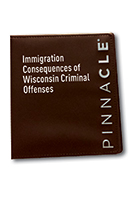 VERDICT: Touchdown!
VERDICT: Touchdown!
Immigration Consequences of Wisconsin Criminal Offenses
By Davorin J. Odrcic (Madison, WI: State Bar of Wisconsin PINNACLE™, 2015). $179 member; $229 nonmember. Order here.
Reviewed by Saša Johnen
Criminal defense lawyers who are not well-versed in immigration law should seriously consider adding Immigration Consequences of Wisconsin Criminal Offenses by Attorney Davorin J. Odrcic to their library. The U.S. Supreme Court has held that defense lawyers are required to discuss potential immigration consequences with their noncitizen clients. This book is an invaluable resource because it helps defense lawyers exceed this requirement and helps to navigate the complexities of representing noncitizens. The detailed analysis of immigration consequences of the most common Wisconsin criminal offenses and sections on practical advice on securing outcomes that avoid or minimize issues for noncitizens make this book a must-have.
Before delving into the particulars of “crimmigration,” the interplay between criminal and immigration law, readers are introduced to Servio’s story. Servio’s tale illustrates the terrible situations noncitizens can be placed in years after they unknowingly pleaded to charges carrying severe immigration consequences. While Servio’s story had a happy ending by him eventually becoming a U.S. citizen, many of his troubles could have been avoided.
The author analyzes the U.S. Supreme Court decision in Padilla v. Kentucky, 559 U.S. 356 (2010), in detail. Padilla placed a Sixth Amendment duty on defense lawyers to discuss potential immigration consequences with clients. In cases in which it is clear that the offense will have immigration consequences, defense counsel must provide noncitizens with accurate advice about the consequences. In cases that are less clear, defense lawyers must only give a warning that a plea “may carry” immigration consequences. While two recent Wisconsin Supreme Court decisions seem to suggest that the duty under Padilla is satisfied by giving the immigration warning in the plea questionnaire,the author cautions that Padilla represents the bare minimum of what is required under the Sixth Amendment.
Want to Review a Book?
Please request a book and writing guidelines from Wisconsin Lawyer managing editor Karlé Lester, at klester@wisbar.org or (608) 250-6127. Reviewers may keep the book reviewed. Reviews of about 500 words are due within 45 days of receiving the book. Reviews are published, space permitting, in the order received and may be edited for length and clarity.
The book achieves its self-proclaimed goal to equip lawyers to go well beyond the bare minimum requirements set by Padilla. Key immigration terms are explained in an easy-to-understand manner. The process of analyzing immigration consequences, called ICIDA (immigration history, criminal record, inadmissibility, deportability, and avoiding removal), is succinctly described and then explored in more detail in following chapters. A chapter filled with examples of how the ICIDA approach is applied further aids in understanding the process.
The comprehensive analysis of approximately 80 of the most commonly charged criminal offenses in Wisconsin and recommended advice for each offense are particularly helpful. The book shares practical advice on how to determine if the client is a noncitizen, developing case strategy, recommendations on fee agreements, plea negotiations, and useful questionnaires and checklists.
Overall, this book equips defense lawyers to maneuver the complex and intimidating field of crimmigration. While cases may arise in which it is necessary to consult with an immigration lawyer, the requirements placed on defense counsel by Padilla can be met. Thanks to Attorney Odrcic’s book, defense lawyers will be much better positioned to counsel noncitizen clients as to potential immigration consequences.
Saša Johnen, U.W. 2013, practices traffic and criminal defense at Johnen Law Offices in Madison.
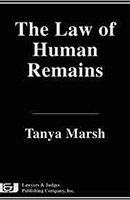 VERDICT: Touchdown!
VERDICT: Touchdown!
The Law of Human Remains
By Tanya Marsh (Tucson, AZ: Lawyers & Judges Publishing Co., 2016). 528 pgs. $165. Order,
www.lawyersandjudges.com.
Reviewed by Dick Ebbott
In a stupendously thorough compendium of the law of human remains in the United States, author Tanya Marsh takes us from the determination of when a person transitions to become human remains to the rights for those remains to rest in peace. I know, you’re wondering why you need a book like this. Here are three examples from my practice that may provoke some thoughts.
-
The funeral home employees are having trouble negotiating a tight corner with a casket bearing a very large deceased individual. The bier tips, dumping the casket and disturbing the remains. The family sues.
-
A sibling obtains some of the deceased person’s cremains from the funeral director, puts them in special containers, and passes them out to the family. Another family member who was supposed to receive all the cremains is distraught because the deceased has been divided. He sues.
-
On a more generic note, the family squabbles over such things as organ donation, cremation, funeral service, burial, and so on.
All knowledge is useful, and what is most useful about this book is knowing that it exists. I don’t recommend a copy for every office, but county, state, and law school libraries should have one. I’m donating my copy to the courthouse law library in my county.
Using her exceptional research and organizational skills, Marsh begins with English and U.S. common law and combines it with historic church law. In a very interesting way, she leads us through the history of the law of human remains and the bases for present common and statutory law. Who knew that Samuel B. Ruggles, a New York lawyer tapped to write a report for Surrogate Court in the 1850s, thus contributed to equity courts having jurisdiction over human remains (eliminating any ecclesiastical claims) and set out five fundamental principles that are embodied in today’s laws.
Part I has well-thought-out chapters that, in addition to the common-law and statutory-law history, include topics such as determining death, options on disposition of the remains, regulation of the funeral industry, and the treatment of remains thereafter. Part II (422 pages) has a chapter for each state for easy reference. Divided into six main categories, each chapter starts with the state’s code and organizations and goes through some 33 topics all the way to the laws on protests at funerals. The entire book is very well annotated.
Did you know that in Wisconsin, if you are aware of a death and the deceased person had not been seen by a physician or religious healer during the 30 days before he or she died, you have a statutory duty to report the death to the sheriff or other official? Or that if your client wants the hymn “In the Garden” sung at her funeral and you put that in her will, it may be binding on the person designated to carry out her wishes? Anything, anything concerning the law of human remains in the United States – this is the book.
Dick Ebbott, U.W. 1967, practices with Morrissey, Bove & Ebbott in Flint, Mich.
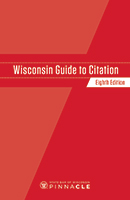 VERDICT: Touchdown!
VERDICT: Touchdown!
Wisconsin Guide to Citation, 8th Edition
By Editors with contributions from Melissa Greipp et al. (Madison, WI: State Bar of Wisconsin PINNACLE™, 2016). 80 pgs. $29 member; $36.25 nonmember. Order here.
Reviewed by Marisa L. Kasriel
If you’re a stickler for proper citation formatting, you’ll appreciate having a copy of the Wisconsin Guide to Citation in your legal writing reference library. This handy, state-specific companion to The Bluebook offers in-depth guidance on how to properly cite to Wisconsin court opinions and litigation documents, administrative agency adjudications, attorney general opinions, municipal and county ordinances, and more.
Where applicable, each subsection of this book is keyed to a corresponding rule in The Bluebook, which makes cross-referencing a breeze. Navigating this guide is further aided by an intuitively ordered table of contents in the front and, in the back, tables of cases, statutes, regulations, and Bluebook rules, along with a detailed subject index.
Throughout the Wisconsin Guide to Citation, the authors have included helpful notes, practice tips, and cautions, which contain interesting minutiae about little known court rules, discrepancies between The Bluebook and the Wisconsin Supreme Court’s citation preferences, and historical fun facts. For instance, were you aware that reprints of the first 22 volumes of the Wisconsin Reports have two sets of page numbers because those in the original volumes, which are now out of print, do not match the page numbers in the republished editions? Now, you’re probably wondering, how does one properly cite to the cases in these first 22 volumes? The note in section III.A.1. of the Wisconsin Guide to Citation has the answer.
In addition to its printed format, the Wisconsin Guide to Citation is also available online with a Books Unbound subscription through the State Bar of Wisconsin. After interacting with this book both online and in print, I personally prefer the print version. The spiral bound hard copy has the same, familiar look and feel as The Bluebook, and leafing through its pages brings back fond memories of my days spent checking cites for the Marquette Law Review. (However, those who would rather forget their stints as cite checkers might prefer the online version of this guide.)
In sum, if you practice before Wisconsin’s state courts or administrative bodies and you’re a citation wonk like me, the Wisconsin Guide to Citation is a must-have companion guide to supplement your beloved Bluebook.
Marisa L. Kasriel, Marquette 2014, practices with Buelow Vetter Buikema Olson & Vliet LLC in Waukesha.
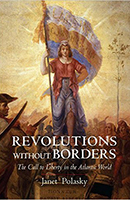 VERDICT: It’s a Keeper
VERDICT: It’s a Keeper
Revolutions Without Borders: The Call to Liberty in the Atlantic World
By Janet Polasky (New Haven, CT: Yale Univ. Press, 2015). 392 pgs. $35 (hardcover), $25 (paper). Order, www.yalebooks.com.
Reviewed by Dianne Post
Revolutions Without Borders is a look at the American and French revolutions in conjunction with other failed and successful revolutions, including the abolition of slavery around the Atlantic Ocean from Halifax to Port-au-Prince, from Belgium to Freetown. To its credit, the book includes the actions of women and African-Americans, too often ignored by other history books.
Between 1776 (continental North America) and 1804 (Haiti), revolution loomed over four continents. The focus on liberty, except for Blacks, was an international movement driven by ideas that traveled by pamphlets, letters, novels, journals, and eventually newspapers. Politics no longer was the exclusive province of the privileged and instead flourished in taverns, coffee shops, and clubs, and in salons often hosted by women.
The American Revolution excluded Blacks and did not count them among those who deserved liberty. The Haitian revolution made clear that Blacks would not accept that exclusion. American Blacks sought freedom from the British after the Revolution and many traveled to Nova Scotia. When there, too, they found discrimination, many sought freedom in Sierra Leone, where they established Freetown. The migration to Sierra Leone resulted in the problems of any invader who moves into the lands of another, but the American Blacks were buoyed by the British guns. They still did not find “liberty,” however, because the British quickly exchanged slavery for colonization.
The same French who lauded their own revolution did all they could to quash that of the Blacks in the French Caribbean. King Louis XVI went so far as to dismantle every press in Saint-Dominque to prevent the spread of liberty to the colonies. But shipmates brought revolutionary materials and ideas from France to Haiti. The Americans supported the French in attacking Haiti by establishing a total quarantine to keep the idea of Black liberty from the North American continent’s shores.
To the surprise of the French, many of the Caribbean “slaves” had been soldiers in African armies captured by British and French slavers. They knew how to organize and fight. The alliance of freed men and slaves on the islands was particularly frightening. But for the Haitians, it was slavery or death. They chose liberty.
The ideas of liberty did not pass women by. Mary Wollstonecraft was one of many women who challenged the presumed superiority of men. Correspondence between spouses showed that the ideas had spread into the family as well, not only the political sphere.
Several historical figures fought or fomented several different revolutions, taking what they learned in one to the next. The parallels with today’s world are inescapable. The Internet spreads revolutionary ideas of liberty. Nations rose up in the Arab Spring only to see their revolutions beaten down, as happened on the European continent. Lawyers often played prominent roles in the revolutions described in the book, and they still do today because liberty is many lawyers’ stock in trade.
Dianne Post, U.W. 1979, is an international human rights lawyer. She practiced family law in Arizona for 18 years, mostly representing battered women and molested children, and then in 1998 began doing international work mainly on gender-based violence.
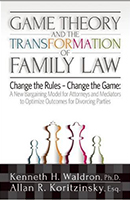 VERDICT: Touchdown!
VERDICT: Touchdown!
Game Theory and the Transformation of Family Law
By Allan R. Koritzinsky & Kenneth H. Waldron (Scottsdale, AZ: Unhooked Books, 2015). 342 pgs. $39.95. Order, www.unhookedbooks.com.
Reviewed by Kelly Kramer
When I first picked up this book, my biggest fear was that because it discussed game theory it necessarily involved math, which filled me, a family law attorney, with dread. However, the book is an outstanding contribution to the field of family law. This book is required reading for any family attorney with an interest in how game theory, bargaining tools, and conflict-resolution methods can be used to devise solutions to complicated family law issues that accomplish both parties’ goals.
No matter the outcome, parties to a divorce rarely walk away feeling satisfied or positive about the experience, even if they might have legally “won” and received what they claimed they wanted. Using a combination of game theory methodology and social science research, the book provides lawyers with new and creative methods for devising optimal solutions when negotiating settlements involving all aspects of family law from child custody and placement to property division.
Fortunately, very little math is involved, even in the examples that use formulas to clarify a point. Additionally, caveats provided here and there throughout the book acknowledge that some clients will remain steadfastly unreasonable and irrational despite any amount of game theory or social science knowledge. Although I appreciated the reminders, most family lawyers are already more than familiar with that fact.
Another aspect the book touches on that I believe is supremely under acknowledged is that the current U.S. family law legal system for the most part promotes litigation and conflict rather than rational problem solving. As family lawyers, we are supposed to be problem solvers, and the problems we are asked to solve often involve complex financial questions or issues concerning the lives of children and highly emotional and irrational people.
This book offers valuable tools and methods for lawyers to use not only to help parties reach an optimal settlement in the short term but also to help them discover solutions that will provide a lifetime of benefits. Lawyers, especially family lawyers, frequently choose this challenging career to make a positive difference in their client’s lives, and the reality is that feedback of this sort from clients is heard far too little. Putting the concepts described in this book to use will definitely increase the chance of lawyers hearing words of gratitude from their clients.
Divorce is one of the most traumatic experiences individuals go through, and the negative effects can last a lifetime, typically leaving permanent scars on both the adults and the children involved. If the methods in this book are applied correctly, divorcing couples will be able to achieve more than satisfactory solutions that leave all spouses able to heal and not only move on with their lives but also lead more fulfilling lives in the future. This book has the potential to significantly and positively affect divorce litigation and settlement.
Kelly Kramer, Hamline 2013, is an attorney at Herrick & Hart S.C., Eau Claire, and a writer for Source HOV.
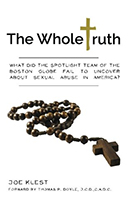 VERDICT: It’s A Keeper
VERDICT: It’s A Keeper
The Whole Truth: What Did the Spotlight Team of the Boston Globe Fail to Uncover About Sexual Abuse in America?
By Joe Klest (Schaumburg, IL: Klest Injury Law Firm, 2016). 152 pgs. $11.95. Order, www.amazon.com.
Reviewed by Alyssa A. Dudkowski
This book is a response from a legal viewpoint to the winner of this year’s Oscar for Best Picture, “Spotlight.” I had not seen “Spotlight” before reading this book, but I watched it afterward. The author’s experience in this challenging area of the law definitely qualifies him to share relevant perspective on the topic of sexual abuse of minors. The book is a short read and there is no mistaking the author’s main points. In fact, my only critique of the book is that the author unnecessarily repeats his points.
The book provides the background setting for “Spotlight” and, as the book’s title indicates, strives to tell aspects of the situation not portrayed in the movie. One of the author’s main points is that the Catholic Church had already implemented significant, systematic changes to its handling of cases of clerical sexual abuse well before the Boston Globe’s Spotlight team published their story. The author expresses positive support for the implemented reforms. Another main point of the author is the significant body of charitable work done and supported by the Church both in the United States and around the world.
It was a third, main point that had the greatest impact on me and which I will not forget. The author expresses his viewpoint (supported by seemingly credible sources) that, as a society, we do not prioritize adequate protection of our children and adolescents. While institutions such as the Catholic Church provide a sensational subject for media coverage, children are actually at greater risk of becoming victims of inappropriate and criminal behavior in schools and in organized activities for youth. There have not been widespread calls to action for putting protective systems in place in these settings. The book provides the details of a 2004 U.S. Government Accountability Office report that estimated that just under 10 percent of K-12 students in U.S. schools are subjected to instances of sexual misconduct. The data have not been refreshed since 2004.
As a parent, I agree with the author that greater attention and investment is needed to ensure that vulnerable children are protected from adult predators. To that end, the author concludes the book with three calls to action for parents and guardians, and he provides an extensive list of resources for victims and survivors of abuse. I recommend this book – particularly if you were drawn to see the movie, “Spotlight.”
Alyssa A. Dudkowski, DePaul 2015, is in-house counsel with Kimberly-Clark Corporation in Neenah.
